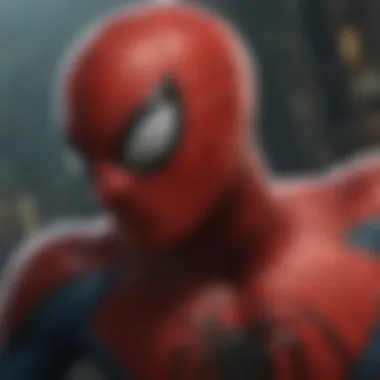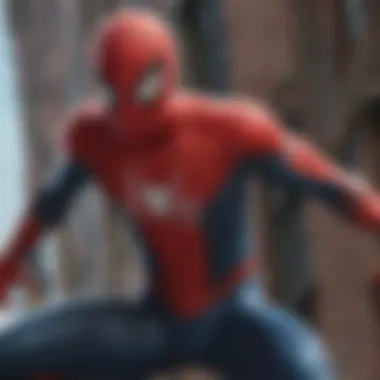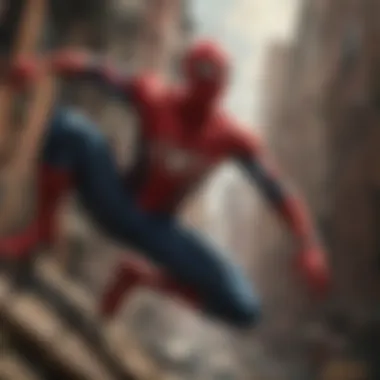Exploring the Hidden Depths of Spider-Man


Intro
When one thinks of Spider-Man, familiar images of swinging through the urban jungle of New York City, battling iconic villains, and a young man's struggle with responsibility come to mind. But beneath this well-trodden surface, there lies a treasure chest of stories often overlooked by the casual fan. This article aims to peel back the layers, revealing untold tales that enrich the Spider-Man mythos and explore the depths of a character who has fascinated generations. From the intricate dynamics of his relationships to the diverse alternate realities that unfold, we invite you on a journey through the shadows of Spider-Man’s universe, where every corner holds a story worth telling.
Spider-Man Character Analysis
Background
Spider-Man, created by Stan Lee and Steve Ditko, first swung into existence in "Amazing Fantasy #15" in 1962. With the realization of his powers came an age-old lesson about power and responsibility. The character’s evolution reflects not just the changes in comic book storytelling but also the shifting societal norms over decades. From being that awkward teenager dealing with high school bullying to a superhero grappling with cosmic threats, Spider-Man’s trajectory is one of continual adaptation.
Powers and Abilities
What sets Spider-Man apart from many other heroes is not just his web-slinging prowess or wall-crawling abilities. His physical strength, agility, and spider-sense auralate a higher sense of danger. But beneath the surface, his intellect is where his true power lies. The character has often leveraged his scientific know-how to outsmart foes. This mix of physical and mental acuity makes him a unique figure in the superhero landscape.
Character Development
Spider-Man’s journey is sprinkled with moments that shape who he is. One shining example is the tragic death of Uncle Ben, forever ingrained in his psyche. It is a turning point that cements his moral compass. Over the years, we have seen him grapple with relationships, love, and loss. Characters like Mary Jane Watson and Gwen Stacy each leave an indelible mark on his heart, showcasing the dual struggle of being a superhero and a human. His character development is an intricate dance of balancing his dual identity while confronting his own insecurities and fears.
Infamous Altrealities
Spider-Man’s universe is vast, teeming with alternate realities that introduce us to different versions of the beloved hero.
- Spider-Man 2099: Set in a dystopian future, Miguel O'Hara takes up the mantle, presenting a cyberpunk twist to the traditional story.
- Spider-Gwen: Here, Gwen Stacy is bitten by the radioactive spider, leading to a fresh take on familiar narratives that flips expectations.
- The Spider-Verse: This overarching storyline brings together Spideys from various Earths, showcasing diversity long before it became a mainstream conversation in comic circles.
"Every iteration introduces a new audience to what Spider-Man represents: heritage, resilience, and adaptation."
These alternate tales challenge our perceptions while still echoing the core values that make Spider-Man resonate across cultures.
Closure
Prelims to Spider-Man's Lesser-Known Stories
Spider-Man, as a character, has been at the center of comic book culture for decades. His vibrant character and complex narrative arc have led to numerous tales. However, beneath the well-known stories lies a treasure trove of lesser-known narratives that offer a fresh perspective on his journey. These untold tales aren’t just footnotes in the Spider-Man saga; they expand the universe in remarkable ways, revealing not only Peter Parker's character but also the broader implications of his world. By delving into these narratives, readers can appreciate the multi-dimensional facets of this iconic superhero.
What sets these lesser-known stories apart isn’t merely their obscurity but their capacity to explore themes often overshadowed by more prominent arcs. For instance, the quieter moments in a hero's life often reveal profound truths about sacrifice, loyalty, and personal growth. When one steps outside the mainstream narratives, it becomes clear that Spider-Man's universe is populated with underappreciated characters and complex relationships that enrich the overall narrative.
"The real treasure lies in the stories untold, where the essence of the character brews beneath the surface."
The Significance of Untold Tales
The significance of these untold tales cannot be overstated. They serve as an opportunity for fans to reconsider their understanding of Spider-Man. These stories often introduce new perspectives on established characters and narratives. As fans engage with these lesser-explored arcs, they might find connections to the contemporary issues faced in real life, making the tales feel relevant and timeless.
Additionally, untold tales foster character development that isn’t seen in mainstream discourse. Characters such as Mary Jane Watson and Harry Osborn gain depth beyond their romantic and rival dynamic with Peter Parker. The evolution of Mary Jane from a damsel to a proactive character in her own right is often overlooked, yet brings significant weight to the overarching storyline.
Why Explore Beyond the Mainstream?
Exploring beyond the mainstream is akin to uncovering hidden gems in a vast ocean of comics. Often, the more popular arcs receive the lion’s share of attention, but there’s a wealth of narratives that offer valuable insights into the core of who Spider-Man is. By digging deeper, we can see the interconnected threads of narrative and character development that highlight the intricacies of the Spider-Man universe.
Consider how alternate realities, like the multiverse featuring characters such as Spider-Gwen and Spider-Man Noir, expand the idea of what it means to be Spider-Man. Each alternative version tackles unique challenges and themes that resonate with diverse audiences. This diversity enriches the overall Spider-Man mythos by illuminating different aspects of heroism, identity, and morality.
In sum, by exploring these lesser-known stories, both die-hard and casual fans gain a broader understanding of Spider-Man’s legacy, enriching their comic book experience while also sparking discussions about themes relevant to contemporary society.


Characters Who Deserve More Spotlight
Delving into Spider-Man's universe reveals a landscape dotted with characters who often fade into the background. These characters are more than mere sidekicks or antagonists; they represent pivotal elements that enrich the entire narrative. The tales of these characters deserve a moment in the limelight, allowing fans to explore the depths of their stories that mainstream portrayals often overlook.
By highlighting them, we not only broaden the lore around Spider-Man but also provide insights into the themes of friendship, betrayal, and even growth that these characters embody. Whether they have been supporters or adversaries, each plays a role in sculpting Spider-Man's identity. Taking the time to explore them enhances our understanding of his journey and the stakes involved.
Their stories often dive into the less glamorous aspects of heroism, giving readers a well-rounded perspective. It’s easy to overlook these gems in favor of the more powerful and recognized figures, but by doing so, we miss a wealth of intricate plots and interactions that add layers to the hero's mythos.
The Unsung Heroes of Spider-Man's Universe
From Peter Parker's uneasy allies to those ensnared in the web of his numerous adventures, unsung heroes offer a transformational perspective. One standout is Gwen Stacy, who, despite her tragic fate, has carved her own niche, particularly through the rise of Spider-Gwen. In another vein lies Flash Thompson, shifting from bully to a heroic figure in his own right as Agent Venom. These characters challenge the typical narrative arc and serve not just as tragic figures or annoyances but as essential elements in Spider-Man's life, reflecting the complexities of human relationships.
Villains with Depth: More than Just Antagonists
Spider-Man's rogues' gallery is not just a collection of villains; it features deeply layered characters who showcase motivations beyond simple evil plans.
Kraven the Hunter
Kraven the Hunter is emblematic of a villain whose backstory injects a level of complexity into the Spider-Man saga. This character's obsession with proving himself as the greatest hunter in the world causes him to target Spider-Man not out of malice but as part of an existential quest. The nuanced portrayal of Kraven reveals a man at odds with himself, fighting to redefine his legacy. This makes Kraven a captivating topic for exploration in the overarching narrative as it allows for themes of honor and the burdens of ambition to surface.
However, his unique characteristic lies in the sheer intensity of his belief in the hunt. This obsession, while driving the character, serves as a double-edged sword. He may achieve temporary glory but at the cost of his humanity, making his storyline a poignant reflection of the dark side of ambition within the superhero genre.
The Chameleon
The Chameleon stands out for his mastery of disguise, an ability that symbolizes the themes of identity and deception running through Spider-Man's universe. Beyond being a mere criminal, The Chameleon highlights the fragility and complexity of identity. His character represents how masks—whether literal or metaphorical—play a significant role in not only superhero stories but in life itself.
What makes The Chameleon particularly compelling is his lack of a clear agenda. Unlike many villains, he isn’t driven by personal vendettas or great power; rather, he lures us into a world of intrigue. The life of a master of disguise tells a narrative of constant reinvention, exposing the very fears of invisibility and recognition that haunt many characters in this universe. This aspect can bring to light deeper discussions about self-worth and validation, opening doors to richer dialogues among fans.
Vulture's Evolving Role
The Vulture serves as a noteworthy example of character evolution—initially depicted as an elderly villain, he eventually became a metaphor for aging and relevance in a youthful world. His transformation from a selfish criminal to a more multi-dimensional figure showcases personal growth that often mirrors real-world concerns about age and legacy.
His unique feature of technology enhancement didn't just bolster his physical abilities but offered insights into the ethical dilemmas surrounding aging and empowerment in a society increasingly obsessed with youth. By seein the Vulture’s arc, readers witness a complex interplay between ambition, desperation, and the undeniable passage of time, making him a perfect fit within the themes of our exploration into Spider-Man's universe.
Alternate Realities: Expanding the Spider-Man Mythos
The concept of alternate realities in Spider-Man's universe opens up a treasure trove of narratives that significantly enrich the storytelling landscape. When exploring Spider-Man, many fans often stick to the traditional tales told through Peter Parker's eyes. However, unraveling these alternate dimensions not only broadens the scope of the Spider-Man mythos but also reveals layers of complexity within the characters and themes that make Spidey so enduring. The varying perspectives and unique circumstances of alternate realities challenge the idea of a singular narrative. They enable exploration of what could happen when key events take a different turn or when characters evolve in unexpected ways.
By integrating alternate realities, creators can also tackle larger cultural issues, flipping established norms on their head. With richer backstories and unique character arcs, these tales contribute to a deeper understanding of morality, resilience, and identity in ways that straightforward narratives may miss.
Spider-Verse: A Multidimensional Exploration
The Spider-Verse is perhaps one of the most significant developments in contemporary Spider-Man lore. It ushers in a vibrant world where countless iterations of Spider-People coexist across different dimensions. This setup allows for inventive storytelling that highlights variations in character traits, motivations, and even ethical dilemmas.
Within this multitude, we see characters that reflect diverse backgrounds, lives, and choices. This not only diversifies the Spider-Man narrative but also invites broader audience engagement. Readers from various walks of life can find representation among these Spider-People, fostering a sense of belonging and connection to the overarching Spider-Man legacy.
"Every Spider-Man has a story, and every story is a reflection of its time and place."
Impact of Alternate Spider Mena
Spider-Gwen


Spider-Gwen is a standout character that emerged from the Spider-Verse concept. Her unique tale presents a refreshing twist on the classic Spider-Man narrative. In this alternate universe, Gwen Stacy becomes the wall-crawler instead of Peter Parker. This shift is notable as it not only flips traditional roles but also explores themes of gender, empowerment, and identity.
Her key characteristic lies in her strong sense of justice and commitment to her friends, often placing them ahead of her own struggles. The appeal of Spider-Gwen in this context is her relatability – she grapples with issues familiar to many, like balancing personal losses with the responsibility of heroism. The unique feature of Spider-Gwen is her distinctive style, both in terms of costume and storytelling. Utilizing punk rock and alternative aesthetics, she brings a fresh pulse to the Spider-Man universe that resonates with a younger audience.
However, her narrative can pose challenges too, as balancing her identity as a superhero and an ordinary young woman can lead to a somewhat complicated storyline.
Spider-Man Noir
Spider-Man Noir has a compelling narrative set against the backdrop of the Great Depression. This version of Spider-Man exists in a universe characterized by a darker, grittier tone, influenced heavily by crime and socioeconomic struggles. The key characteristic of Spider-Man Noir is his gritty realism and moral ambiguity. Instead of swinging through brightly colored cityscapes, he operates in a world where every shadow hides a threat.
His unique feature lies in the fusion of classic noir tropes with superhero elements, creating a refreshing take for audiences who appreciate detective stories and historical narratives. This character invites exploration of social themes like class disparity and corruption, providing a richer discourse on heroism.
However, as a darker counterpart, Spider-Man Noir might alienate readers looking for the light-hearted humor typically associated with Spider-Man.
Superior Spider-Man
Then there's the Superior Spider-Man, an interesting twist that shifted perceptions about who should be the hero. In this arc, Doctor Octopus swaps minds with Peter Parker, prompting an exploration of what it truly means to be Spider-Man. The key characteristic of the Superior Spider-Man is his ruthless approach to crime-fighting. He believes in ruling through fear, raising questions about morality and the true essence of heroism.
What makes this character fascinating is the opportunity it provides to examine how power can corrupt even the best of intentions. The unique feature of the Superior Spider-Man is his willingness to cut corners, leading to a moral debate among fans regarding the ethics of his methods. Though controversial, this narrative allows for deeper discussions around legacy, responsibility, and the spirit of the hero.
In summary, these alternate Spider-Men expand the realm of possibilities within the Spider-Man saga. They allow for narratives that entertain as much as they provoke thought, exploring what makes a hero in vastly different contexts. Through these lesser-known tales, fans can gain a multifaceted understanding of Spider-Man and the world around him.
Key Story Arcs that Went Under the Radar
Spider-Man has had his fair share of well-touted adventures, often overshadowed by the blockbuster events and main continuity storylines. However, buried beneath this sea of iconic tales lie key story arcs that possess unique contributions to his development and the overarching narrative of the Spider-Man universe. By diving into these lesser-discussed tales, we can appreciate the layered complexities of Spider-Man's character and the richness of his world—a treasure trove waiting to be explored by both new fans and longtime enthusiasts.
Among these underappreciated arcs are the controversies and transformations that add depth to Spider-Man's mythology. They highlight pivotal moments that shaped not just Spider-Man's fate but also the emotional landscape of those around him. Engaging with these stories allows readers a broader view of how struggles and relationships outside the spotlight have influenced Spider-Man, making him more relatable and profound.
The Clone Saga: Controversy and Depth
The Clone Saga stands as a landmark in Spider-Man lore, often viewed as a double-edged sword. Initially celebrated for introducing significant developments in Peter Parker’s life, it quickly became embroiled in criticism and confusion. The central premise of this saga revolved around the emergence of Ben Reilly, a clone of Peter Parker, who challenges Peter's identity and legacy.
At its core, the Clone Saga served multiple functions—even as critics denounce it as convoluted, it dared to explore themes of identity, belonging, and moral complexity. Readers witnessed Peter grappling with the very essence of who he was. The narrative's winding plot threaded through pivotal moments:
- The emotional upheaval when Peter questions his own existence and choices
- Ben Reilly’s struggle for acceptance in the shadow of a man he is supposed to mimic
- The exploration of villainy through characters like the Jackal, who manipulates these emotions to serve nefarious ends
The controversy, however, cannot be ignored. As storylines stretched on and timelines tangled, fans felt lost, leading to mixed reviews. This narrative tension did lead to revitalization, forcing writers post-saga to rethink how they handle character continuity and audience engagement.
"In the world of Spider-Man, every thread of storytelling weaves into the next. The Clone Saga, despite its setbacks, reminds us that even moments of turbulence have the power to provoke introspection."
Spider-Man: The Other - A Transformation
Next up, we have Spider-Man: The Other, a story arc that sought to redefine the classic hero. This tale ignited an exploration into Peter Parker’s vulnerabilities and strengthened his foundation—not just as a superhero, but as a human being. It confronted mortality head-on and framed Spider-Man’s struggles in a light that blended the fantastical with the deeply personal.
In The Other, Spider-Man faces a formidable new threat, which culminates in a transformative experience. The story illustrates his battles—both physical and psychological—reflecting a genuine fight for survival. Through a series of trials, he loses not only his confidence but confronts the very fabric of his being. Key elements of this transformation include:
- A Higher Power: The narrative invokes themes of spirituality and rebirth, positioning Spider-Man against a force that calls into question his very existence
- Death and Rebirth: Peter’s demise and subsequent rebirth symbolize the cyclical nature of struggles, echoing a belief in renewal even amidst despair
- Individual Growth: His evolving relationships with characters like Mary Jane and Aunt May also highlight growth, illustrating how love serves as a cornerstone in overcoming darkness
Ultimately, Spider-Man: The Other encapsulates not just the trials of heroism, but of humanity itself. This transformation, albeit fantastical, resonates with readers on a visceral level, making it a significant part of Spider-Man's untold tales.
The Role of Supporting Characters


In the intricate tapestry of Spider-Man’s narrative, the supporting characters often act as the threads that bring a richer, more vivid picture to life. They are not just sidekicks or background figures but are pivotal in shaping Peter Parker's identity and guiding his journey as a superhero. Their roles enhance the depth of the storyline and provide layers of connectivity that resonate with the audience, making the overall saga far more relatable and engaging.
The significance lies not only in their interactions with Spider-Man but also in their personal narratives, which sometimes intertwine with the broader themes of the series. Through their successes, struggles, and relationships, they reflect the complexities of human experiences. Additionally, these characters help to ground the often fantastical elements of Spider-Man's world in reality, bridging the gap between the superhero and the everyday.
Mary Jane Watson and Her Evolution
Mary Jane Watson is perhaps one of the most notable supporting characters in Spider-Man’s universe. Initially introduced as a love interest, her character has undergone tremendous evolution over the years. She transitioned from a seemingly carefree party girl into a strong, independent woman who stands firmly beside Peter Parker.
"She’s not just the damsel in distress; she’s a force in her own right."
Today, Mary Jane represents resilience and growth. She has navigated various challenges, from her relationship with Peter to her own career aspirations in the arts. Through this journey, her character has consistently exemplified empowerment, encouraging viewers to recognize the strength in vulnerability. Moreover, her evolving relationship with Peter showcases the dynamic of partnership that transcends traditional roles.
Mary Jane’s evolution isn’t solely about her romance with Spider-Man. It also illustrates broader themes of personal growth and self-identity. Her journey reflects the struggle many face when balancing love and ambition. In a way, she acts as a mirror that reflects Peter's own battles with responsibility and yearning for personal fulfillment. This underlies the notion that behind every superhero, there is a story worth telling.
Harry Osborn: Friendship and Rivalry
Harry Osborn, the son of Norman Osborn, embodies a different layer of supporting narratives in Spider-Man’s world. His friendship with Peter Parker is one of the series’ most complex dynamics; it permeates themes of loyalty, rivalry, and ultimately, tragic consequences.
Harry starts as the epitome of a supportive friend, but his journey takes a darker turn, illustrating how power, legacy, and familial pressures can fracture relationships. The contrast between Harry and Peter emphasizes the duality of their friendship and reveals how jealousy and ambition can lead to dire outcomes.
Though they were like brothers at one point, Harry’s transformation into a rival when he adopts the Green Goblin identity showcases the tragic fall from grace. This development adds layers to both characters and prompts readers to examine the consequences of circumstances beyond one's control.
In essence, Harry Osborn serves as a cautionary tale of how friendship can be influenced by external factors, leading to tumultuous outcomes. His rivalry with Spider-Man also brings forth discussions on moral boundaries and the nature of good versus evil, making his character crucial in the overall Spider-Man narrative.
Through Mary Jane and Harry, we see how supporting characters can pivotally affect Spider-Man's journey, challenging him, shaping him, and reflecting the broader human experience. Their stories offer insights that enrich the Spider-Man legacy, reminding us that every hero’s journey is interwoven with the lives of others.
Cultural Impact and Interpretations
The cultural significance of Spider-Man stretches far beyond the comic book pages. It’s not just about webs and villains but how this character resonates with diverse audiences across generations. Spider-Man embodies the everyman, giving people a sense of hope and courage even amidst adversities. This article unpacks how various cultural interpretations have emerged, influencing not only the superhero genre but societal narratives altogether.
Spider-Man in Popular Culture
Spider-Man has seamlessly woven himself into the fabric of popular culture. The influence manifests in a myriad of ways—from memes to merchandise, and even Halloween costumes. The character's relatability is perhaps the cornerstone of this phenomenon. Unlike many superheroes, Spider-Man is often depicted as struggling with the same issues any young adult might face: work problems, relationship dynamics, and the trials of growing up.
- Iconic Symbol: The red-and-blue suit is more than a costume; it's become a symbol of resilience. Many brands have adopted Spider-Man’s logo, demonstrating how potent the imagery is.
- Crossover Appearances: Spider-Man appears in various media aside from comics—animation series, live-action films, and even video games. Each adaptation contributes to a broader appreciation of the character. For example, the successful animated series in the 90s and the more recent films put Spider-Man back into the spotlight, connecting with both old and new fans.
- Memes and Internet Culture: Nowadays, if there’s a meme, there’s a good chance Spider-Man is involved. Whether it’s the iconic pointing meme or various fan artworks, Spider-Man continues to trend, reflecting contemporary social issues, and making him relatable on a personal level.
"What Spider-Man represents is more than just a hero. He’s a reflection of society’s struggles, dreams, and aspirations."
The Legacy of Spider-Man in Literature and Film
The literary journey of Spider-Man has paved the way for intricate storytelling with depth. From earnest themes of responsibility to sheer existential dilemmas, the character has been intricately developed over decades. In literature and film, several interpretations bring forth new layers of complexity.
- Adaptations Across Mediums: Different filmmakers bring their unique perspectives to Spider-Man's character, from Sam Raimi’s classic trilogy to the more recent animated ventures like Spider-Man: Into the Spider-Verse. Each version explores different elements of his persona, capturing an audience that appreciates diversity in interpretation.
- Complex Narratives: These adaptations often examine societal concerns, showing how Spider-Man is affected by contemporary issues like mental health, corporate ethics, and the impact of technology. For instance, the Miles Morales saga emphasizes cultural diversity and the weight of legacy, making it relevant to today's youth.
- Influences on Story Arcs: The evolution of Spider-Man’s narrative has influenced countless characters in both comics and cinema. New heroes have emerged, many of whom apply similar themes of responsibility and self-doubt, reinforcing Spider-Man's archetype as a relatable superhero.
In examining cultural impact and interpretations, it becomes clear that Spider-Man transcends being just a comic book character. He is interwoven with the evolving narrative of society itself, making his tales as relevant today as they were when he first swung into action.
Ending: The Ever-Evolving Narrative of Spider-Man
In exploring the lesser-known stories surrounding Spider-Man, we uncover an intricate tapestry of narratives that showcase not just the hero himself but the broader universe in which he operates. This conclusion is pivotal in emphasizing that Spider-Man's evolution is not merely a sequence of plots, but a rich assortment of threads woven together through time. The character's journey reflects societal changes, personal growth, and the challenges faced by those living in a complex world.
Understanding Spider-Man's ever-evolving narrative allows us to appreciate the varying dimensions of his character—from a fun-loving teenager in high school to a symbol of resilience and sacrifice in dire situations. We're not just talking about Spidey swinging through skyscrapers anymore; it’s about the depth of his friendships, the darker moments of his story arcs, and the impact of his choices. The character has been shaped by countless writers and artists, each bringing their perspective and ideas to the forefront.
Looking Ahead: Future Stories to Explore
Future Spider-Man stories promise to delve even deeper into unexplored territories. Here are several exciting directions that might be taken:
- An In-Depth Look at Side Characters: Characters like Miles Morales might take center stage again, allowing for a nuanced exploration of identity and legacy.
- Revisiting Iconic Arcs: Re-imagining classic narratives with modern themes, such as loss or mental health, can bring fresh insights into what makes Spider-Man relatable across generations.
- Expanding the Spider-Verse: As the multiverse concept continues to gain popularity, we might see lesser-known Spider variants receiving the attention they deserve. Characters like Spider-Ham or Spider-man 2099 could have their own arcs, building on themes of humor or futuristic dilemmas.
- Crossover Events: Future comic events could see Spider-Man teaming up with characters from other comic universes in a way that adds layers to his character while paying homage to the genre as a whole.
- Social Commentary: Given the current social climate, new stories could reflect contemporary issues, showing how Spider-Man addresses real-world challenges while staying true to his core values.
As Spider-Man continues to grow within his own right, we anticipate rich and thrilling tales that will shape the legacy of this beloved character for years to come. Spider-Man's narrative will always adapt, evolve, and resonate with the hearts of fans, deepening our appreciation for a hero who truly embodies the spirit of perseverance and hope.





